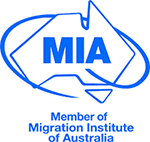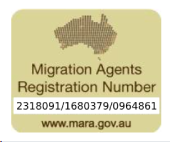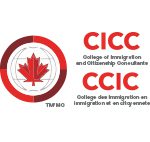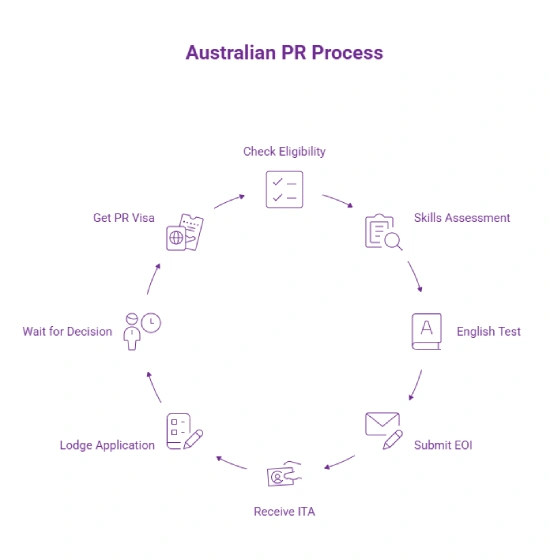How to Apply Australia Permanent Residency (PR) Visa – Process, Eligibility & Benefits
Applying for an Australia Permanent Residency (PR) Visa opens the door to a secure future in one of the world’s most livable countries. Australia’s PR pathways are designed for skilled professionals, families, and entrepreneurs who wish to build a long-term life in the country.
With a transparent, points-based system, streamlined visa options, and strong government support for migration, Australia continues to attract thousands of new residents each year. The process involves meeting eligibility criteria, scoring competitively under the SkillSelect system, and submitting a complete application through the Department of Home Affairs.
What Is Australia Permanent Residency (PR) Visa?
An Australia Permanent Residency (PR) Visa allows individuals from around the world to live, work, and study in Australia indefinitely. It is primarily meant for skilled professionals, families of Australian citizens or PR holders, and investors or business owners who want to make Australia their long-term home.
As a permanent resident, you enjoy most of the rights and privileges of Australian citizens, including access to Medicare (public healthcare), free or subsidized education, and social security benefits once eligible. PR holders can also sponsor eligible family members and apply for Australian citizenship after meeting the required residency period.
Why Apply for an Australia PR Visa?
Applying for an Australia Permanent Residency (PR) Visa offers long-term stability, a high standard of living, and access to the same opportunities enjoyed by Australian citizens. As one of the world’s most welcoming and prosperous nations, Australia provides PR holders with numerous benefits that make it an ideal destination for skilled migrants and families.
Top Benefits of Getting Australia PR
-
Live, Work, and Study Anywhere in Australia
PR holders can freely live and work in any state or territory without employer or regional restrictions.
-
Access to Medicare (Public Healthcare)
Enjoy Australia’s world-class Medicare system, which provides free or subsidized medical care and hospital services.
-
Quality Education for Children
Children of PR holders can attend public schools at no cost, and tertiary education is offered at domestic student rates.
-
Strong Job Market and Career Growth
Australia has a robust economy with ongoing demand for skilled workers across sectors such as healthcare, IT, engineering, and education.
-
Pathway to Citizenship
After fulfilling the residency requirement (typically four years of lawful stay, including one year as a permanent resident), PR holders can apply for Australian citizenship.
-
Social Security and Family Benefits
After a qualifying period, permanent residents become eligible for certain social security and family support benefits under Services Australia.
Types of Australia Permanent Residency (PR) Visas
Australia offers several visa pathways to obtain Permanent Residency (PR), each tailored to different applicant profiles such as skilled professionals, employers, investors, entrepreneurs, and family members of citizens or permanent residents. Below are the main PR visa streams under the Australian Government’s Migration Program.
Skilled Migration Stream – Points-Based Australia PR Visa (Subclass 189, 190, 491)
The Skilled Migration Stream is the most popular pathway to permanent residency. It operates through a points-based system under SkillSelect, assessing applicants on age, education, work experience, English proficiency, and other factors.
Key visa options include:
- Subclass 189 (Skilled Independent Visa): For skilled workers who are not sponsored by an employer or state.
- Subclass 190 (Skilled Nominated Visa): For individuals nominated by an Australian state or territory government.
- Subclass 491 (Skilled Work Regional Visa – Provisional): A five-year regional visa that provides a pathway to PR after three years of residence and work in a designated regional area.
Applicants must score at least 65 points to be eligible for an invitation. Invitation rounds are conducted periodically by the Department of Home Affairs based on Australia’s labour market demand.
Employer-Sponsored Australia PR Visa (Subclass 186, 187)
The Employer Nomination Scheme (Subclass 186) and Regional Sponsored Migration Scheme (Subclass 187) allow skilled workers to obtain PR through employer nomination.
Key features:
- The sponsoring employer must be approved and offer a full-time position in an eligible occupation.
- Applicants must meet age, skills, and English language requirements.
- Once approved, holders gain permanent residency and the right to work for any employer in Australia after the initial obligation period.
Business and Investment Australia PR Visa (Subclass 188/888)
For investors and entrepreneurs, the Business Innovation and Investment Program (BIIP) offers a pathway to PR through innovation and capital contribution.
Key visa types:
- Subclass 188 (Provisional): For business owners, investors, and entrepreneurs who wish to establish or manage a business in Australia.
- Subclass 888 (Permanent): Allows holders of the Subclass 188 visa to transition to permanent residency after meeting business performance and residency requirements.
Applicants must demonstrate a successful business history, meet minimum investment or turnover thresholds, and be nominated by a state or territory government.
Family and Partner Stream Australia PR Visa
This stream allows Australian citizens and PR holders to sponsor close family members to live in Australia permanently.
Main visa options include:
- Partner Visa (Subclass 820/801 and 309/100): For spouses or de facto partners of Australian citizens or PRs.
- Parent Visa (Subclass 103 and 804): For parents of Australian citizens or PR holders.
- Child Visa (Subclass 101/802): For dependent children of Australian citizens or PRs.
These visas aim to reunite families and provide them with the right to live, study, and work in Australia indefinitely.
Humanitarian & Refugee Australia Permanent Residency Pathway
Australia also grants permanent residency through its Humanitarian Program to people fleeing persecution or conflict.
Key visa options:
- Refugee Visa (Subclass 200–204): For individuals referred by the UNHCR and accepted under Australia’s humanitarian intake.
- Global Special Humanitarian Visa (Subclass 202): For individuals sponsored by Australian citizens, PR holders, or organizations.
Holders of these visas receive permanent residence, access to healthcare and education, and protection under Australian law.
Key Eligibility Criteria for Australia Permanent Residency (PR) Visa
To qualify for an Australia Permanent Residency (PR) Visa, applicants must meet the following requirements set by the Department of Home Affairs. These apply mainly to skilled migration pathways (Subclass 189, 190, and 491) but are also relevant for other PR streams.
| Eligibility Factor | Requirement (as per Department of Home Affairs) |
| Age Limit | Must be under 45 years at the time of invitation for skilled PR visas. Applicants aged 25–32 years receive maximum age points under the points test. |
| Education & Skills Assessment | Must hold a recognized qualification relevant to the nominated occupation. A positive Skills Assessment from an authorized body (e.g., ACS, Engineers Australia, VETASSESS) is mandatory. The occupation must be listed on the Skilled Occupation List (SOL) or Regional Occupation List (ROL). |
| Work Experience | Minimum 1 year of full-time skilled work experience in the last 10 years. Extra points are awarded for 3, 5, or 8 years of experience. Australian work experience in a related occupation earns additional points. |
| English Language Proficiency | Must demonstrate English ability through approved tests (IELTS, PTE Academic, TOEFL iBT, OET, or Cambridge C1 Advanced). Minimum level: Competent English (IELTS 6.0 or PTE 50 in each band). Higher scores (Proficient/Superior) earn bonus points. |
| Proof of Funds | Must show sufficient financial capacity to support yourself and dependents after arrival. Required funds vary depending on visa subclass and number of dependents. |
| Health & Character | Must complete a medical examination by an approved panel physician and obtain Police Clearance Certificates from all countries lived in for 12+ months in the past 10 years. Must meet health and character standards to be granted PR. |
Australia Permanent Residency (PR) Visa Points System
The Australia PR Points System determines eligibility for skilled migration visas such as Subclass 189, 190, and 491. Managed under the SkillSelect system, applicants must score at least 65 points to qualify for an invitation to apply for permanent residency.
Points are awarded based on factors that assess your ability to contribute to Australia’s economy and society.
| Category | Maximum Points | Criteria |
| Age | Up to 30 points | Highest points for ages 25–32; zero after age 45. |
| English Language Proficiency | Up to 20 points | Competent English (IELTS 6.0 each band) = 0 points, Proficient (IELTS 7.0) = 10 points, Superior (IELTS 8.0) = 20 points. |
| Skilled Work Experience (Outside Australia) | Up to 15 points | 3–4 years = 5 points, 5–7 years = 10 points, 8+ years = 15 points. |
| Skilled Work Experience (In Australia) | Up to 20 points | 1–2 years = 5 points, 3–4 years = 10 points, 5–7 years = 15 points, 8+ years = 20 points. |
| Educational Qualifications | Up to 20 points | Doctorate = 20, Bachelor/Master’s = 15, Diploma/Trade = 10. |
| Australian Study Requirement | 5 points | For completing at least 2 academic years of study in Australia. |
| Specialist Education Qualification | 10 points | For postgraduate studies in STEM (Science, Technology, Engineering, Maths) fields. |
| Partner Skills | Up to 10 points | For partners under 45 with competent English and a positive skills assessment. |
| State or Territory Nomination (Subclass 190) | 5 points | For being nominated by an Australian state or territory. |
| Regional Nomination (Subclass 491) | 15 points | For being sponsored by a regional employer or family member. |
| Other Factors | 5–10 points | For completing a Professional Year in Australia, community language credentials (NAATI), or having a relative in a regional area. |
Minimum Requirement: A total of 65 points is required to lodge an Expression of Interest (EOI). However, higher scores (typically 85+) increase the chances of receiving an invitation during selection rounds.
*Check your eligibility to become a Permanent Resident of Australia with the FREE Australia immigration Points Calculator and get an instant score!
How to Increase Your Points for Australia PR Visa
Here are effective ways to boost your overall points score under the Australian PR system:
- Improve your English test results – Aim for a Superior English score (IELTS 8.0 or PTE 79) to earn up to 20 points.
- Gain more skilled work experience – The more years of relevant work, the higher your score (up to 35 combined for overseas + Australian experience).
- Complete higher education – A Master’s or PhD qualification can add 15–20 points.
- Get a state or regional nomination – Subclass 190 adds 5 points; Subclass 491 adds 15 points.
- Claim partner points – If your partner meets skill and language requirements, you can gain up to 10 extra points.
- Complete a Professional Year Program or NAATI certification – Adds 5 points and strengthens employability in Australia.
Step-by-Step Process to Apply for Australia Permanent Residency (PR) Visa
Follow these key steps to apply for an Australia PR Visa through the official Department of Home Affairs process.
Step 1 – Choose the Right Australia PR Visa Subclass
Select the visa that matches your profile — Subclass 189 (Independent), Subclass 190 (State Nominated), or Subclass 491 (Regional). Each has unique eligibility criteria and nomination rules.
Step 2 – Get Skills Assessment and English Test
Obtain a positive Skills Assessment from an authorized assessing body and complete an approved English test (IELTS, PTE, TOEFL, OET, or Cambridge).
Step 3 – Submit Expression of Interest (EOI)
Create and submit your EOI through SkillSelect, including your age, qualifications, work experience, and English scores. You’ll receive a points score that determines your eligibility for invitation.
Step 4 – Receive Invitation and Apply for PR
If selected, you’ll receive an Invitation to Apply (ITA). Submit your visa application online via ImmiAccount within 60 days, along with required documents and fees.
Step 5 – Wait for Decision and Get PR Grant
IRCC reviews your application and may request biometrics or medicals. Once approved, you’ll receive your Visa Grant Notice, confirming your permanent resident status in Australia.
Documents Required for Australia Permanent Residency (PR) Visa
- Valid Passport – A clear, unexpired passport for all applicants included in the visa.
- English Language Test Results – Results from an approved test (IELTS, PTE Academic, TOEFL iBT, OET, or Cambridge C1 Advanced) taken within the last three years.
- Skills Assessment Report – Positive Skills Assessment from an authorized assessing body (e.g., ACS, Engineers Australia, VETASSESS) relevant to your nominated occupation.
- Educational Certificates and Transcripts – Copies of academic qualifications and transcripts from recognized institutions.
- Proof of Work Experience – Reference letters, employment contracts, payslips, or tax records showing relevant skilled experience.
- Expression of Interest (EOI) Summary – Details of your submitted EOI through SkillSelect with your claimed points.
- Proof of Funds – Bank statements or financial documents demonstrating sufficient funds to support yourself and dependents (as applicable for regional or provisional visas).
- Health Examination Results – Medical reports from a panel physician approved by the Department of Home Affairs.
- Police Clearance Certificates – Issued by all countries where you have lived for 12 months or more in the past 10 years.
- Relationship Documents – Marriage or birth certificates, if applying with family members.
- Passport-sized Photographs – Recent digital or printed photos meeting visa photo specifications.
Australia Permanent Residency (PR) Visa Fees and Processing Time
The cost and processing time for an Australia Permanent Residency (PR) Visa depend on the visa subclass, number of dependents, and individual circumstances. All fees are set and reviewed by the Department of Home Affairs and must be paid in Australian dollars (AUD).
| Category | Maximum Points | Criteria |
| Age | Up to 30 points | Highest points for ages 25–32; zero after age 45. |
| English Language Proficiency | Up to 20 points | Competent English (IELTS 6.0 each band) = 0 points, Proficient (IELTS 7.0) = 10 points, Superior (IELTS 8.0) = 20 points. |
| Skilled Work Experience (Outside Australia) | Up to 15 points | 3–4 years = 5 points, 5–7 years = 10 points, 8+ years = 15 points. |
| Skilled Work Experience (In Australia) | Up to 20 points | 1–2 years = 5 points, 3–4 years = 10 points, 5–7 years = 15 points, 8+ years = 20 points. |
| Educational Qualifications | Up to 20 points | Doctorate = 20, Bachelor/Master’s = 15, Diploma/Trade = 10. |
| Australian Study Requirement | 5 points | For completing at least 2 academic years of study in Australia. |
| Specialist Education Qualification | 10 points | For postgraduate studies in STEM (Science, Technology, Engineering, Maths) fields. |
| Partner Skills | Up to 10 points | For partners under 45 with competent English and a positive skills assessment. |
| State or Territory Nomination (Subclass 190) | 5 points | For being nominated by an Australian state or territory. |
| Regional Nomination (Subclass 491) | 15 points | For being sponsored by a regional employer or family member. |
| Other Factors | 5–10 points | For completing a Professional Year in Australia, community language credentials (NAATI), or having a relative in a regional area. |
Note: Visa application charges are reviewed periodically by the Department of Home Affairs. Additional surcharges apply for card payments.
Average Processing Times
| Visa Subclass | Average Processing Time |
| Subclass 189 – Skilled Independent | 7 to 10 months |
| Subclass 190 – Skilled Nominated | 8 to 12 months |
| Subclass 491 – Skilled Work Regional (Provisional) | 9 to 14 months |
| Subclass 186 – Employer Nomination Scheme | 5 to 11 months |
Note: Processing times vary depending on the completeness of your application, nomination availability, occupation demand, and health/security clearances.
Additional Costs
Apart from the visa application charge, applicants should also budget for:
- Medical Examination: AUD 300–450 per person (depending on the clinic and tests required).
- Police Clearance Certificates: AUD 100–200 (varies by country).
- Biometrics Fee (if applicable): AUD 85 per applicant.
- Translation or Notarization of Documents: Based on document volume and certification requirements.
Benefits of Australia Permanent Residency (PR) Visa
-
Live, Work, and Study Anywhere in Australia
PR holders can freely reside and work in any Australian state or territory without employer or location restrictions.
-
Access to Medicare and Social Security
Eligible PR holders can access Medicare, Australia’s public healthcare system, which provides free or subsidized medical services. After a qualifying period, they may also be eligible for social security and family assistance through Services Australia.
-
Pathway to Australian Citizenship
After four years of lawful stay, including one year as a permanent resident, you can apply for Australian citizenship through the Department of Home Affairs.
-
Sponsor Eligible Family Members
Permanent residents can sponsor spouses, children, parents, or dependent relatives for PR or temporary visas, helping families reunite in Australia.
-
Free or Subsidized Education for Children
Children of PR holders can attend public schools at no cost, and tertiary education is offered at domestic tuition rates, significantly lower than international student fees.
-
Social and Economic Stability
PR holders enjoy job security, access to fair employment laws, and protection under the Australian legal system and Fair Work Act.
Maintaining Your Australia Permanent Residency (PR) Visa
To keep your Australia Permanent Residency (PR) status valid, you must meet specific residency and travel obligations set by the Department of Home Affairs. While permanent residency gives you the right to live in Australia indefinitely, your travel facility (the right to re-enter Australia) is time-limited and must be renewed when necessary.
Residency Obligation
- As a PR holder, you can stay in Australia indefinitely, but to maintain re-entry rights, you must spend at least 2 years (730 days) in Australia within every 5-year period.
- Time spent overseas may count if you are accompanying an Australian citizen spouse or working for an Australian business abroad.
5-Year Travel Facility Rule
- Most PR visas include a 5-year travel facility, allowing you to leave and return to Australia freely within that period.
- After it expires, your permanent resident status remains valid, but you’ll need a Resident Return Visa (RRV – Subclass 155 or 157) to re-enter Australia as a permanent resident.
Renewing or Extending PR Status
- If your travel facility has expired and you wish to travel internationally, apply for an RRV through the Department of Home Affairs.
- To qualify for a 5-year RRV, you must have lived in Australia for at least 2 of the last 5 years as a permanent resident.
- Those who do not meet the residency requirement may still be eligible for a 1-year RRV if they demonstrate substantial ties to Australia (business, employment, or family).
Pathway from Australia Permanent Residency (PR) Visa to Citizenship
Becoming an Australian citizen is the final step after obtaining permanent residency, offering lifelong security, full civic rights, and access to Australia’s passport. The Department of Home Affairs manages the citizenship process, which includes meeting residency, good character, and knowledge requirements.
Eligibility for Australian Citizenship
To apply for citizenship by conferral, you must:
- Have lived in Australia for at least 4 years lawfully, including at least 1 year as a permanent resident.
- Have been present in Australia for at least 9 months in the year immediately before applying.
- Meet the good character requirement for applicants aged 18 and over.
- Pass the Australian Citizenship Test, which assesses knowledge of Australia’s values, history, and responsibilities.
- Have a basic understanding of English language and demonstrate commitment to living in Australia long term.
Benefits of Becoming an Australian Citizen
- Full Civic Rights – Vote in federal and state elections and stand for public office.
- Australian Passport – Travel freely with one of the world’s most powerful passports, offering visa-free access to 180+ countries.
- Lifetime Status – No need to renew a visa or maintain travel facilities; citizenship is permanent.
- Access to Additional Government Support – Eligibility for full social security benefits, scholarships, and public sector employment.
- Protection Abroad – Receive consular assistance from Australian embassies while travelling or living overseas.
Common Mistakes to Avoid When Applying for Australia Permanent Residency (PR) Visa
Applying for an Australia Permanent Residency (PR) Visa is a detailed process, and even small errors can delay or result in refusal of your application. The Department of Home Affairs emphasizes accuracy, complete documentation, and meeting eligibility criteria at every stage.
Here are the most common mistakes applicants should avoid:
- Choosing the Wrong Visa Subclass
Many applicants select the incorrect visa type (e.g., applying for Subclass 189 instead of 190). Each subclass has specific eligibility and nomination requirements — choosing the right one is crucial.
- Submitting Incomplete or Incorrect Documentation
Missing documents like employment references, skills assessments, or proof of funds can lead to delays or refusal. Ensure all documents meet Home Affairs’ format and certification rules before uploading to ImmiAccount.
- Expired English Test or Skills Assessment
IELTS/PTE results are valid for three years, while most Skills Assessments remain valid for three years from the issue date. Submitting expired documents can invalidate your application.
- Incorrect Points Calculation
Misstating work experience, education level, or English proficiency in your Expression of Interest (EOI) can result in rejection if evidence doesn’t match. The Department cross-checks all claims with documentation.
- Failing to Update EOI Information
Not updating your SkillSelect profile when gaining new qualifications, test results, or experience can lower your chances of receiving an invitation. Always keep your EOI accurate and current.
- Ignoring Health and Character Requirements
Omitting medical examinations or police certificates from all relevant countries can delay processing or lead to refusal. These are mandatory for every PR applicant and dependent.
- Applying Without Checking State or Regional Nomination Lists
For Subclass 190 or 491, applicants often overlook updated State Migration Lists or occupation quotas, leading to ineligible applications. Always verify your occupation before applying.
How Can Y-Axis Help You?
Y-Axis, the leading overseas immigration consultancy in the UK, provides unbiased immigration services for every client based on their interests and requirements. The impeccable services of Y-Axis include:
- Free eligibility check through Australia Immigration Points Calculator
- Expert guidance/counseling for Australian Immigration
- Coaching services: Expert CELPIP coaching, IELTS proficiency Coaching
- Free career counseling; book your slot today
- Complete guidance for Australia PR visa
- Job search services to find related jobs in Australia
Our Accreditations |
|||
 |
 |
 |
 |
Looking for Inspiration
Explore what Global Citizens have to say about Y-Axis in shaping their future
Frequently Asked Questions

.webp)

